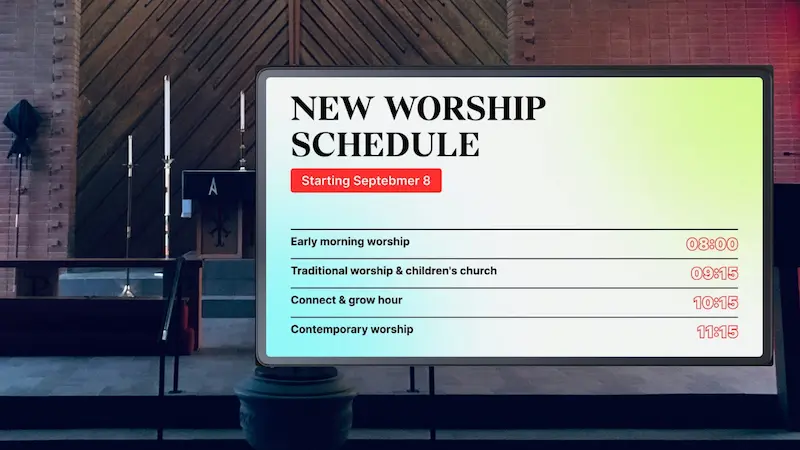
Table of Content
Digital signage has become the driving force behind the advertising and communication strategies of businesses across various industries. Companies are now able to tell their story to a broader audience in a way that captures their attention and gets them to seek additional information. The data sufficiently prove the efficacy of digital signage.
In this article, we are looking at digital signage statistics at a wider scale and then niche down to individual industries.
Digital Signage Global Market Statistics
The global digital signage market is witnessing significant growth, driven by advancements in display technology, increasing demand for personalized and interactive content, and the rising adoption of digital signage in various industries.
The global digital signage market was valued at $18.7 billion in 2020 and is projected to reach $26.1 billion by 2028, growing at a CAGR of 6.9% during the forecast period.
This growth is attributed to the demand for high-resolution displays in commercial settings, the rapid growth of technological advancements, and the demand for digital signage in infrastructural applications.
Retail is the largest application segment for digital signage and takes up a significant market share. However, other sectors, such as transportation, healthcare, hospitality, and education, are also adopting digital signage solutions.
North America dominates the global digital signage market, followed by Europe and Asia Pacific. The Asia Pacific region is expected to witness significant growth due to increasing investments in infrastructure development and the retail sector.
Growth Trends Across Industries

Retail
94% of retailers use or have used digital signage to reimagine and improve their customers' in-store experience. 80% of them consider it important to make those experiences a reality.
Apart from positive customer experiences, 20% of retailers believe digital signage will help them stand out from their competitors.
40% of retailers say that digital signage is an essential part of their customer's in-store experiences, while another 40% say it’s important for specific purposes or a set of purposes.
68% of customers say digital signage would make them more likely to buy advertised products.
Displaying sales and promotions on your digital displays can skyrocket your sales by 30%.
Storefront digital displays entice customers to enter a store, driving foot traffic by 17%.
Healthcare
Placing digital screens that include queue-management information such as estimated waiting times in waiting areas can help lower anxiety, alleviate frustration, and reduce the perceived wait time by as much as 35%.
In the medical industry, digital signage can be effective in conveying information to patients. A study found that 75% of hospital patients could recall at least one message from a digital sign.
One survey by ReferralMD found that 83% of patients spend a significant amount of time on a hospital's digital content.
78% of patients say they actively seek digital health solutions whenever possible.
52% of patients get some health information from digital signage.
Corporate
60% of employees feel more informed about company initiatives and events through digital signage. This improves employee engagement and helps create a cohesive corporate culture.
Deploying digital signage in corporate settings has been shown to have a positive impact on sales and revenue. Research indicates that digital signage can increase sales by up to 30%.
Good internal communication, facilitated by digital signage, can drive 25% higher employee productivity. This is supported by The State of Business communication report that revealed that 72% of business leaders have seen a significant increase in their team productivity due to effective communication.
Companies that communicate effectively are 4x more likely to report high levels of employee engagement.
Hospitality
Hotels and Restaurants
55% of travelers indicated they would be more likely to visit a hotel that offered self-check-in kiosks.
70% of hotel guests find digital signage engaging.
Digital menu boards in restaurants and bars have the potential to increase sales by over 30%.
A case study of one European restaurant conducted by NEC Display Solutions Europe showed an 11.5% sales increase after deploying digital signage in their business model.
TDn2K reported that restaurants with digital menu boards experienced an average sales increase of 8%, with certain establishments observing boosts as substantial as 37%.
79% of patrons have stated that technology makes the experience of dining in a restaurant better.
Fast Casual and QSR
Kiosks and digital signage boards can increase average customer spending by 20-30%.
Digital signage has been found to make customers two times more likely to order dessert.
Digital menus are one of the deciding factors when ordering for almost 30% of diners. This is because they help minimize wait time and help customers customize their orders to their liking.
A report by food-service research firm Technomic revealed a 30% increase in drive-thru traffic between 2019 and 2022, highlighting the importance of digital signage in capturing the attention of customers.
Transportation industry
Digital signage in transportation facilities can be used to display emergency alerts, safety instructions, and evacuation procedures.
According to a survey, 72% of travelers find digital signage in airports to help navigate their journey.
According to a study, 46% of travelers recall seeing advertising messages displayed on digital signage in transportation hubs. Transportation providers can generate additional revenue by selling advertising space on digital signage displays.
Advertising

DOOH
As of 2022, almost four out of 10 consumers surveyed in 11 countries reported visiting a website thanks to a digital display.
More than one-third of respondents said they used a hashtag seen on a DOOH ad, while almost one-quarter scanned a QR code.
98% of consumers have visited a DOOH venue type in the last 30 days, with 74% specifically mentioning going to the grocery store.
49% of consumers noticed digital street-level OOH advertising in the past month.
69% of viewers took some sort of action after seeing a digital street-level ad, such as searching for an advertiser online, visiting their business in person, or posting to social media.
Out of five advertising channels, consumers said that billboards and in-store digital displays were the two they found the least annoying.
71% of people feel that advertising on digital billboards stands out more than online ads, and 46% believe it is more prominent than television ads
LED advertising signs can generate 1000 impressions for a mere $0.15, making it a cost-effective form of advertising.
In-House
Digital displays attract four times as many views compared to static displays.
The recall rate for digital advertising signage is 83%, which is twice as high as that of traditional advertising.
Regarding brand awareness, digital posters exhibit an impressive effectiveness rate of 47.7%.
Signage has influenced the purchasing decisions of 68% of Americans, leading them to pay for a product or service.
64% of digital signage users cite increased customer engagement as its main benefit.
Digital signage can lead to a 46% increase in customer satisfaction.
Education
73% of educational institutions believe that digital signage will be essential to communication in the future.
Digital signage in libraries has a 46% probability of capturing attention, leading to enhanced foot traffic and improved library usage.
The adoption rate of digital signage in educational institutions has reached 87%, with institutions recognizing its potential to enhance communication and teaching.
70% of colleges in the US have installed digital displays on campus.
87% of educational institutions, including K-12 schools, have already deployed digital signage systems to streamline communication as well as their lesson plans.
Events
Event technology can help increase event attendance by 20%, increase productivity by 27%, and decrease costs by 20-30%.
Digital media in public venues reaches 70% of Americans, significantly more than the reach of the internet (43%) or Facebook (41%).
Digital signage has a recall rate of 83%, meaning that consumers pay attention to digital ads and remember them.
Consumers find digital signage to stand out more than online ads, with 71% of clients stating that digital signage catches their attention more.
Banking
82% of financial institutions utilize digital signage within their branches.
Over 70% of these institutions employ digital signage in more than half of their branches.
A remarkable 55% have digital signage implemented in over three-quarters of their branches.
Out of over 400 respondents, 65% utilize digital signage beyond branch interiors, such as exterior displays and drive-thrus.
The survey indicates that more than half (52%) of financial institutions produce content internally for their digital signage.
Conclusion
One key insight from digital signage statistics is the importance of data-driven decision-making. Analyzing this data will help you understand customer behavior, preferences, and engagement patterns. These insights can then be used to tailor content and messaging to specific audiences which will result in more personalized and impactful marketing campaigns.
To achieve that, you need a digital signage partner that understands your needs and is adapted to cater to them and grow with your business.
Look Digital Signage software is your signage deployment partner for content creation and management with advanced scheduling capabilities to ensure content display without any hassle. Want to see what we mean? Sign up for a 14-day trial version today and explore all the features without any limitations.






.webp)

